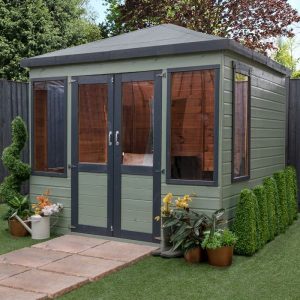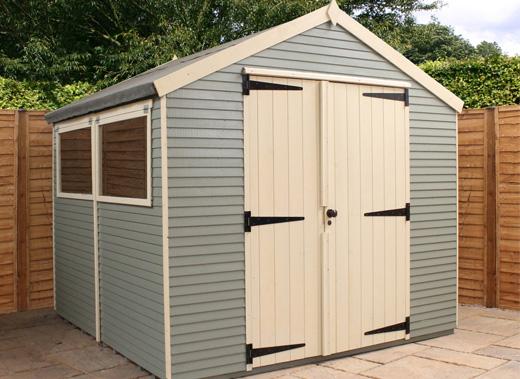How to Maintain a Wooden Shed
When you first buy a new shed, it looks superb. Once you have built and sited it in your garden, you will rightly be proud of the way it looks. You’ll spend some time organising the interior and it will then be a permanent part of your garden.
Unless, of course, you fail to treat it. A wooden shed provides great value and ample storage space. Yet you can make it last even longer by treating it regularly to ensure it can withstand whatever the great British weather can throw at it. (And let’s be honest, that could mean virtually anything!)
What finish?
Wooden sheds can be painted, stained or varnished to your liking. Some manufacturers sell clear wood preserver (Cuprinol, for example) which means you can see the original wood quite clearly through the protective layer. This is good if you want to stay with something natural.
You could also use a wood oil that has been specifically formulated to be used outdoors. Check the label to ensure you have a suitable product. If you have already treated some decking, you could happily use the same thing on your shed to make sure they have a similar look.
Many sheds have already been coated in a layer of wood preservative before they are delivered to you. However, you should still take this early opportunity to treat your new shed and start as you mean to go on.
Something standard… or something more adventurous?

Are you a gardener who loves nothing more than the look of a natural wood shed? Then choose one of the many natural brown shades of wood preservative on the market today. They dry fast and are incredibly easy to apply – just paint them on like you would with a regular tin of paint.
On the other hand, maybe you want to try something a bit different. If you’d like your shed to be a focal point, perhaps finished with a window box packed full of bright blooms, why not choose a coloured wood preservative instead? Cuprinol has one of the biggest ranges of colours you can choose from, providing everything from blues to greens and even a hot pink among others. The Adley 8' x 8' Cornwall Summer House pictured is a great example of how you can use Cuprinol paints to create a fantastic end result.
The great thing about these colours is that they’re designed to bring out the best in the wood. If you bought a wooden shed because you like the look of the grain, you will still be able to see it even when you’ve applied a couple of coats of coloured wood preservative.
How often should you treat your shed?
Ideally, you want to apply a fresh coat of whatever you used originally every single year. wait until you get a couple of days of nice warm weather when no rain is forecast. While many wood finishes are designed to dry and be weatherproof within an hour or two, it’s so much easier to wait until you get a period of dry weather. There’s nothing worse than rushing to complete the last side of the shed while eyeing the big black cloud that’s appeared on the horizon.
Things to remember before you tackle the annual treatment
So… you’re ready to re-apply whatever treatment you gave your shed last year. Before you do so, there’s some preparation to do.
Firstly, take a close look at your shed. Brush off every wooden section and panel to get rid of dust, cobwebs and anything else you don’t want to get caught up in the wood treatment. Check for loose panels and use additional screws or nails to fasten them tight again. Look for any damp areas as they may harbour rotten boards. If so, get the wood hardener out and treat those first. Wait for it to dry – it should harden, making the wood strong again – and then use your wood treatment.
Check the condition of any shed windows as well. Are the pieces of wood holding them in place still in good condition? If not, can you replace them? This might involve cutting new pieces of wood, or using putty if it’s better to do so. A lot will depend on how the windows were installed in the first place. Check the roof as well; while you won’t need to paint or stain this, it may need replacing if the felt has weathered a little too well in the past year.
Taking good care of your shed
By maintaining your shed regularly each year, you’ll notice it lasts a lot longer than those belonging to neighbours who haven’t bothered going through the above routine. A little maintenance also means you can treat yourself to a more expensive shed, in the knowledge you’ll get the very best from it for years to come. Whatever you store in yours, make sure it’s in a safe and solid place.
Other Helpful Articles
How to Insulate a Garden Shed - What Size Shed Should I Buy? - Growing Your Own Vegetables for Beginners - How to Keep Your Shed Tidy



